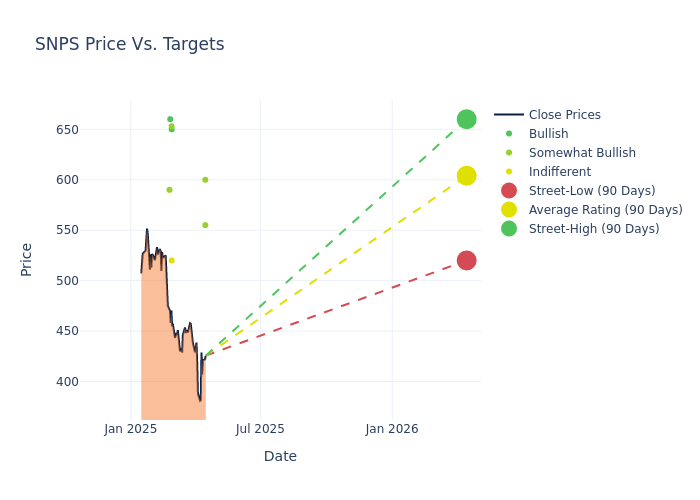What 7 Analyst Ratings Have To Say About Synopsys
During the last three months, 7 analysts shared their evaluations of Synopsys (NASDAQ:SNPS), revealing diverse outlooks from bullish to bearish.
The table below summarizes their recent ratings, showcasing the evolving sentiments within the past 30 days and comparing them to the preceding months.
| Bullish | Somewhat Bullish | Indifferent | Somewhat Bearish | Bearish | |
|---|---|---|---|---|---|
| Total Ratings | 2 | 4 | 1 | 0 | 0 |
| Last 30D | 0 | 2 | 0 | 0 | 0 |
| 1M Ago | 0 | 0 | 0 | 0 | 0 |
| 2M Ago | 2 | 2 | 1 | 0 | 0 |
| 3M Ago | 0 | 0 | 0 | 0 | 0 |
Analysts have set 12-month price targets for Synopsys, revealing an average target of $604.0, a high estimate of $660.00, and a low estimate of $520.00. A negative shift in sentiment is evident as analysts have decreased the average price target by 5.41%.

Exploring Analyst Ratings: An In-Depth Overview
The perception of Synopsys by financial experts is analyzed through recent analyst actions. The following summary presents key analysts, their recent evaluations, and adjustments to ratings and price targets.
| Analyst | Analyst Firm | Action Taken | Rating |Current Price Target| Prior Price Target | |--------------------|--------------------|---------------|---------------|--------------------|--------------------| |Jason Celino |Keybanc |Lowers |Overweight | $555.00|$690.00 | |Siti Panigrahi |Mizuho |Lowers |Outperform | $600.00|$650.00 | |Clarke Jeffries |Piper Sandler |Lowers |Overweight | $653.00|$655.00 | |Charles Shi |Needham |Maintains |Buy | $650.00|$650.00 | |Joe Quatrochi |Wells Fargo |Lowers |Equal-Weight | $520.00|$540.00 | |Blair Abernethy |Rosenblatt |Maintains |Buy | $660.00|$660.00 | |Lee Simpson |Morgan Stanley |Lowers |Overweight | $590.00|$625.00 |
Key Insights:
- Action Taken: Analysts respond to changes in market conditions and company performance, frequently updating their recommendations. Whether they 'Maintain', 'Raise' or 'Lower' their stance, it reflects their reaction to recent developments related to Synopsys. This information offers a snapshot of how analysts perceive the current state of the company.
- Rating: Analyzing trends, analysts offer qualitative evaluations, ranging from 'Outperform' to 'Underperform'. These ratings convey expectations for the relative performance of Synopsys compared to the broader market.
- Price Targets: Analysts explore the dynamics of price targets, providing estimates for the future value of Synopsys's stock. This examination reveals shifts in analysts' expectations over time.
Capture valuable insights into Synopsys's market standing by understanding these analyst evaluations alongside pertinent financial indicators. Stay informed and make strategic decisions with our Ratings Table.
Stay up to date on Synopsys analyst ratings.
Discovering Synopsys: A Closer Look
Synopsys is a provider of electronic design automation software and intellectual property products. EDA software automates and aids in the chip design process, enhancing design accuracy, productivity, and complexity in a full-flow end-to-end solution. Synopsys' comprehensive portfolio is benefiting from a convergence of semiconductor companies moving up the stack of technologies toward systems-like companies, and systems companies moving down-stack toward in-house chip design. The resulting expansion in EDA customers alongside secular digitalization of various end markets benefits EDA vendors like Synopsys.
A Deep Dive into Synopsys's Financials
Market Capitalization: With restricted market capitalization, the company is positioned below industry averages. This reflects a smaller scale relative to peers.
Revenue Growth: Synopsys's revenue growth over a period of 3M has faced challenges. As of 31 January, 2025, the company experienced a revenue decline of approximately -3.68%. This indicates a decrease in the company's top-line earnings. As compared to its peers, the revenue growth lags behind its industry peers. The company achieved a growth rate lower than the average among peers in Information Technology sector.
Net Margin: The company's net margin is a standout performer, exceeding industry averages. With an impressive net margin of 20.32%, the company showcases strong profitability and effective cost control.
Return on Equity (ROE): The company's ROE is below industry benchmarks, signaling potential difficulties in efficiently using equity capital. With an ROE of 3.23%, the company may need to address challenges in generating satisfactory returns for shareholders.
Return on Assets (ROA): The company's ROA is a standout performer, exceeding industry averages. With an impressive ROA of 2.26%, the company showcases effective utilization of assets.
Debt Management: The company maintains a balanced debt approach with a debt-to-equity ratio below industry norms, standing at 0.07.
Understanding the Relevance of Analyst Ratings
Benzinga tracks 150 analyst firms and reports on their stock expectations. Analysts typically arrive at their conclusions by predicting how much money a company will make in the future, usually the upcoming five years, and how risky or predictable that company's revenue streams are.
Analysts attend company conference calls and meetings, research company financial statements, and communicate with insiders to publish their ratings on stocks. Analysts typically rate each stock once per quarter or whenever the company has a major update.
Analysts may supplement their ratings with predictions for metrics like growth estimates, earnings, and revenue, offering investors a more comprehensive outlook. However, investors should be mindful that analysts, like any human, can have subjective perspectives influencing their forecasts.
Breaking: Wall Street's Next Big Mover
Benzinga's #1 analyst just identified a stock poised for explosive growth. This under-the-radar company could surge 200%+ as major market shifts unfold. Click here for urgent details.
This article was generated by Benzinga's automated content engine and reviewed by an editor.
 Wall Street Journal
Wall Street Journal